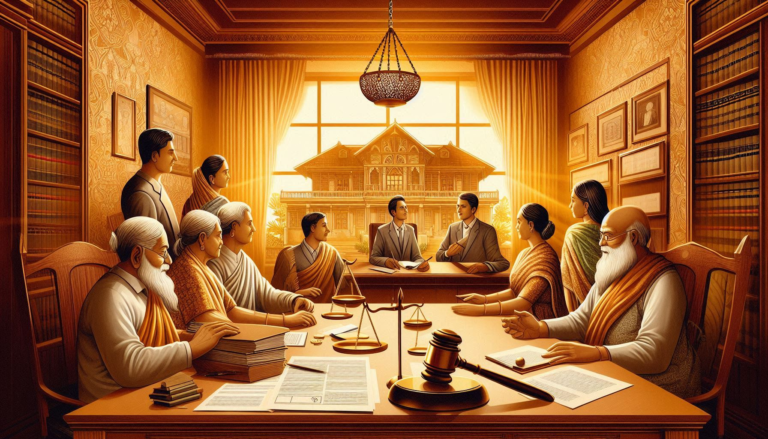
Abstract
The distinction between ancestral and self-acquired property is a cornerstone of property rights in India. While property law, broadly, regulates the ownership, use, and transfer of assets, this binary classification holds unique relevance under Hindu law. Ancestral property symbolizes continuity, passing down through generations and conferring rights by birth upon coparceners, whereas self-acquired property underscores individual autonomy and effort. The classification significantly impacts inheritance, partition, gender equality, and family disputes. Judicial interpretation has continuously reshaped the contours of both categories, with courts addressing issues such as when property loses its ancestral character, how self acquired property can transform into joint family property, and the extent of coparcenary rights after the Hindu Succession (Amendment) Act, 2005. This article situates the debate within the larger framework of property rights, examining statutory provisions, case law, and practical implications in contemporary India.
Introduction
Property rights form the bedrock of socio-legal relations in India. The notion of property, historically tied to wealth and status, continues to influence questions of inheritance, succession, and family harmony. Within this landscape, the distinction between ancestral and self-acquired property acquires particular significance. Although property rights are governed broadly by the Transfer of Property Act, 1882, and the Indian Succession Act, 1925, the nuances of ancestral property are primarily rooted in Hindu personal law, particularly the Mitakshara and Dayabhaga schools.1
Ancestral property is understood as property inherited up to four generations of male lineage without partition, in which every coparcener—by virtue of birth—holds an undivided interest.2 This right by birth distinguishes it from self-acquired property, which vests exclusive ownership in the individual until voluntarily transferred.3 The implications of this difference are far-reaching: coparceners cannot be excluded from ancestral property, whereas self-acquired property may be freely alienated, gifted, or bequeathed at the owner’s discretion.
The Supreme Court has repeatedly emphasized that the classification of property determines not only succession but also the rights of women and children. In CIT v. P.L. Karuppan Chettiar, the Court clarified that property inherited from a father, grandfather, or great grandfather qualifies as ancestral, provided it has not undergone partition. More recently, in Angadi Chandranna v. Shankar,4 the Court held that once joint family property is partitioned, the share allotted ceases to be ancestral and becomes self-acquired in the hands of the allottee. Such decisions demonstrate how the legal character of property is not static but evolves depending on circumstances.
The Hindu Succession (Amendment) Act, 2005, further transformed this field by granting daughters equal coparcenary rights in ancestral property.5 Landmark judgments such as Vineeta Sharma v. Rakesh Sharma6 have reinforced this statutory change, establishing that daughters possess coparcenary rights by birth, irrespective of whether the father was alive at the time of the amendment. This marked a paradigm shift toward gender equality within the framework of property rights.
Against this background, the article critically examines the conceptual foundations of ancestral and self-acquired property, their statutory underpinnings, and judicial interpretations. By situating the distinction within the broader domain of property rights, the paper seeks to highlight not only the legal intricacies but also the social realities and disputes arising from the classification.
Concept of Ancestral Property
Ancestral property is a unique category of property recognized under Hindu law. It is defined as property inherited up to four generations of male lineage that has remained undivided.
Every coparcener—whether son, daughter (after the 2005 amendment), grandson, or great grandson—acquires an interest in such property by birth, not merely upon the death of the owner.
Features of Ancestral Property
The essential features include:
- Right by Birth: Coparceners obtain an undivided share immediately upon birth.
- Unity of Possession: Each coparcener has equal rights, though not specified portions, until partition.
- Restriction on Alienation: No single coparcener can alienate the property without consent of others, except for legal necessity.
- Devolution by Survivorship: Before the Hindu Succession Act, 1956, ancestral property devolved by survivorship rather than inheritance. Post-1956, survivorship applies only to coparcenary property, while separate property devolves by succession.

Judicial Interpretation
The courts have consistently clarified what qualifies as ancestral property.
In CIT v. P.L. Karuppan Chettiar, the Supreme Court held that property inherited from a paternal ancestor (father, grandfather, or great-grandfather) is ancestral, provided it has not been partitioned. Similarly, in Shyam Narayan Prasad v. Krishna Prasad, the Court emphasized that property inherited from a father can retain its ancestral character unless the father made a testamentary disposition treating it as separate.7
However, once partition occurs, the nature of the property changes. In Angadi Chandranna v. Shankar, the Court recently reiterated that property obtained on partition loses its ancestral character and becomes self-acquired in the hands of the allottee.
Another landmark case is Vineeta Sharma v. Rakesh Sharma, where the Supreme Court upheld the equal rights of daughters as coparceners in ancestral property by birth. This decision resolved earlier conflicts in Prakash v. Phulavati and Danamma v. Amar regarding the retrospective operation of the 2005 amendment.
Statutory Framework
The Hindu Succession Act, 1956, codified the law relating to intestate succession among Hindus. Section 6 originally excluded daughters from coparcenary rights, but the Hindu Succession (Amendment) Act, 2005 explicitly conferred equal rights on daughters. Thus, ancestral property today is not limited to the male line but extends equally to daughters.
Concept of Self-Acquired Property
Self-acquired property stands in sharp contrast to ancestral property. It refers to property obtained by an individual through personal effort or independent sources, unconnected to the joint family nucleus. Such property is characterized by the exclusive ownership of the acquirer, who enjoys full rights of disposal during their lifetime. Unlike ancestral property, no person acquires a birthright in self-acquired property.
Sources of Self-Acquired Property
The law recognizes several modes of acquiring self-acquired property: Purchase from Own Income: Property bought out of one’s salary, business profits, or savings is self-acquired. Gifts or Testamentary Dispositions: A gift deed or property received under a will constitutes self-acquired property in the hands of the donee or legatee, unless it is expressly blended with the joint family estate. Partitioned Property: When a coparcener receives a share upon partition, it becomes their separate property and can be treated as self-acquired thereafter. Adverse Possession or Independent Claim: If a member acquires property through adverse possession or independent title, it is classified as self-acquired.
Judicial Interpretation
The Supreme Court has laid down important principles governing self-acquired property. In C.N. Arunachala Mudaliar v. C.A. Muruganatha Mudaliar, the Court held that property received by a son under a will from his father constitutes his separate property and does not automatically assume the character of ancestral property. This principle reinforced the idea that the intention of the donor or testator plays a decisive role in determining the nature of the property. Similarly, in Mallesappa Bandappa Desai v. Desai Mallappa, the Court recognized that income earned by an individual and invested into property acquisition remains self acquired, unless it is shown that the acquisition was made out of the joint family nucleus.8 The burden of proof rests on the party claiming that the property is not self-acquired. In Lal Bahadur v. Kanhaiya Lal, the Court further clarified that the essence of self-acquisition lies in independence from joint family funds, and the onus lies on the party challenging this independence.9
Rights of the Owner
The defining feature of self-acquired property is the absolute power of the owner. The owner may alienate the property by sale, mortgage, or gift without the consent of family members. The property may be bequeathed by will to any person, even to the exclusion of heirs. Family members have no claim during the owner’s lifetime, and only those named in a will or entitled under succession law can inherit upon the owner’s death. This freedom ensures that self-acquired property symbolizes autonomy, distinguishing it from the constraints attached to ancestral property.
Blending and Conversion into Joint Property
Although self-acquired property is originally separate, it can be converted into joint family property by blending. The doctrine of blending holds that when a person voluntarily waives their exclusive rights and mixes self-acquired property with the joint family estate, it becomes part of the coparcenary. However, mere possession of self-acquired property within the family does not result in blending; intention must be proved.
Key Distinctions between Ancestral and Self-Acquired Property
The distinction between ancestral and self-acquired property is pivotal in understanding property rights under Hindu law. While both categories pertain to ownership within a Hindu Undivided Family (HUF), they differ significantly in terms of acquisition, rights, and devolution.
- Mode of Acquisition
- Ancestral Property: Acquired by inheritance up to four generations of male lineage without partition. Rights are conferred by birth, and the property remains undivided among coparceners.
- Self-Acquired Property: Acquired by an individual through personal effort, such as earnings, purchase, or gifts. The owner retains exclusive rights over the property.
- Rights of Coparceners
- Ancestral Property: All male members of the family, by birth, become coparceners and have equal rights in the property.
- Self-Acquired Property: Only the individual owner has rights; others do not acquire any rights by birth.
- Alienation and Transfer
- Ancestral Property: Alienation requires the consent of all coparceners, except in cases of legal necessity.
- Self-Acquired Property: The owner has the absolute right to alienate or transfer the property without any restrictions.
- Devolution Upon Death
- Ancestral Property: Devolves by survivorship among coparceners, unless partitioned.
- Self-Acquired Property: Devolves according to the owner’s will or, in the absence of a will, as per the laws of intestate succession.
- Impact of Partition
- Ancestral Property: Upon partition, the property ceases to be ancestral and becomes self-acquired in the hands of the allottee.
- Self-Acquired Property: Remains self-acquired even after partition.
- Gender Equality
- Ancestral Property: Prior to the 2005 amendment, only male members had coparcenary rights. Post-amendment, daughters have equal rights in ancestral property by birth.
- Self-Acquired Property: Both male and female members have equal rights to inherit self-acquired property.

Practical Implications and Contemporary Issues
The distinction between ancestral and self-acquired property is not merely a theoretical concept; it has profound implications in the social, legal, and economic spheres. Understanding these implications helps families, practitioners, and courts navigate disputes while ensuring compliance with statutory and judicial mandates.
Family Disputes
Family disputes often arise due to confusion over the character of property. Misunderstandings about whether a property is ancestral or self-acquired can result in litigation over partition, inheritance, or alienation. For instance, in Angadi Chandranna v. Shankar, the Court highlighted how partitioned ancestralpropertyconverts into self-acquired property, impacting the claims of other family members. Disputes are exacerbated when documentation is incomplete or informal transfers are made.10
Gender Equality
The Hindu Succession (Amendment) Act, 2005 has significantly strengthened the rights of daughters in ancestral property. Prior to the amendment, daughters were excluded from coparcenary rights. Post-amendment, daughters have equal rights by birth, as reaffirmed in Vineeta Sharma v. Rakesh Sharma. Despite statutory provisions, practical enforcement remains challenging. Cultural norms, lack of awareness, and reluctance by male family members often result in underutilization of these rights.
Succession Planning
Effective succession planning is essential to prevent disputes. Owners of self-acquired property may use wills or gifts to ensure their property is transferred according to personal intent. In joint families, blending self-acquired property with ancestral property should be documented explicitly to avoid confusion over rights. Courts have emphasized that proper documentation and proof of intention are crucial. In C.N. Arunachala Mudaliar v. C.A. Muruganatha Mudaliar, the Supreme Court ruled that without clear evidence, courts cannot assume that self-acquired property was merged into joint family property.
Economic and Social Implications
- Economic Control: Self-acquired property enables individuals to maintain economic autonomy, invest independently, and control wealth distribution.
- Social Stability: Clearly distinguishing between property types reduces litigation and promotes harmony within families.
- Women’s Empowerment: Equal coparcenary rights enhance financial independence and decision-making power for daughters.
Contemporary Legal Challenges
Several challenges persist in practice:
- Proof of Ancestry: Establishing whether a property is ancestral requires detailed genealogical and documentary evidence.
- Partition Complications: Ambiguous partitions can lead to property disputes decades later.
- Blending of Property: When self-acquired and ancestral property are mixed, courts often need to interpret intention, leading to complex litigation.11
Judicial awareness has evolved to address these issues. Courts often adopt a pragmatic approach, focusing on the intention of the parties and documented transactions, while adhering to statutory provisions.to statutory provisions.
Conclusion
The classification of property into ancestral and self-acquired is central to property rights under Hindu law. Ancestral property represents lineage and continuity, conferring birthright upon coparceners, while self-acquired property underscores personal effort and autonomy. Recent judicial trends and statutory amendments, particularly the 2005 Hindu Succession Amendment, have strengthened gender equality, clarified rights upon partition, and emphasized documentation of property transactions.
For families and practitioners, understanding this distinction is crucial for avoiding disputes, planning succession, and empowering all members equally, especially women. As courts continue to interpret and refine these concepts, clarity in acquisition, intention, and documentation remains essential for legal certainty and social harmony.
References
- The Hindu Succession Act, No. 30 of 1956, INDIA CODE, https://indiacode.nic.in/showdata?actid=AC_CEN_3_20_00027_195630_1517807324
- The Hindu Succession (Amendment) Act, No. 39 of 2005, INDIA CODE, https://indiacode.nic.in/bitstream/123456789/151780/1/the_hindu_succession_amendment_act%2C_2005.pdf.
- The Indian Succession Act, No. 39 of 1925, sec 30, INDIA CODE, https://indiankanoon.org/doc/1564987/.
- Transfer of Property Act, No. 4 of 1882, INDIA CODE, https://indiacode.nic.in/show data?actid=AC_CEN_3_20_00004_1882.
Case Law
- CIT v. P.L. Karuppan Chettiar, (1992) Supp. 1 S.C.C. 132, https://www.the laws.com/encyclopedia/browse/case?caseId=218791240000.
- C.N. Arunachala Mudaliar v. C.A. Muruganatha Mudaliar, A.I.R. 1953 S.C. 495, https://indiankanoon.org/doc/1564987/.
- Mallesappa Bandappa Desai v. Desai Mallappa, A.I.R. 1961 S.C. 1268, https://indiankanoon.org/doc/1564987/.
- Lal Bahadur v. Kanhaiya Lal, (1983) 3 S.C.C. 254, https://indiankanoon.org/doc/1564987/.
- Angadi Chandranna v. Shankar, 2025 S.C.C. OnLine SC 1052, https://www.supremecourtcases.com/angadi-chandranna-v-shankar-and-others/.
- Vineeta Sharma v. Rakesh Sharma, (2020) 9 S.C.C. 1, https://papers.ssrn.com/sol3/Delivery.cfm/SSRN_ID4471378_code5795499.pdf?abstr actid=4471378.
- Shyam Narayan Prasad v. Krishna Prasad, (2018) 7 S.C.C. 646, https://indiankanoon.org/doc/1564987/.
- Raghubar Singh v. Gulab Singh, (1998) 6 S.C.C. 314, https://indiankanoon.org/doc/1564987/.
Footnotes
- The Transfer of Property Act, No.4 of 1882, INDIA CODE; The Indian Succession Act, No. 39 of 1925,
INDIA CODE. ↩︎ - CIT v. P.L. Karuppan Chettiar, (1992) Supp. 1 S.C.C. 132 (India). ↩︎
- C.N. Arunachala Mudaliar v. C.A. Muruganatha Mudaliar, A.I.R. 1953 S.C. 495 (India). ↩︎
- Angadi Chandranna v. Shankar, 2025 S.C.C. OnLine SC 1052 (India). ↩︎
- The Hindu Succession (Amendment) Act, No. 39 of 2005, INDIA CODE. ↩︎
- Vineeta Sharma v. Rakesh Sharma, (2020) 9 S.C.C. 1 (India). ↩︎
- Shyam Narayan Prasad v. Krishna Prasad, (2018) 7 S.C.C. 646, 654 (India). ↩︎
- Mallesappa, A.I.R. 1961 S.C. at 1273. ↩︎
- Lal Bahadur v. Kanhaiya Lal, (1983) 3 S.C.C. 254, 259 (India). ↩︎
- Shayam Narayan Prasad v. Krishna Prasad, (2018) 7 S.C.C. 646, https://indiankanoon.org/doc/1564987/. ↩︎
- Raghubar Singh v. Gulab Singh, (1998) 6 S.C.C. 314. ↩︎




